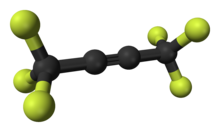Hexafluoro-2-butyne
Appearance

| |

| |
| Names | |
|---|---|
| IUPAC name
1,1,1,4,4,4-hexafluorobut-2-yne
| |
| Other names
HFB
| |
| Identifiers | |
3D model (JSmol)
|
|
| ChemSpider | |
| ECHA InfoCard | 100.010.667 |
PubChem CID
|
|
| RTECS number |
|
CompTox Dashboard (EPA)
|
|
| |
| |
| Properties | |
| C4F6 | |
| Molar mass | 162.034 g·mol−1 |
| Appearance | Colorless gas |
| Density | 1.602 g/cm3 |
| Melting point | −117 °C (−179 °F; 156 K) |
| Boiling point | −25 °C (−13 °F; 248 K) |
| Insoluble | |
| Structure | |
| 0 D | |
| Hazards | |
| Occupational safety and health (OHS/OSH): | |
Main hazards
|
Toxic gas |
| Related compounds | |
Related compounds
|
Dimethyl acetylenedicarboxylate Hexachlorobutadiene Acetylene |
Except where otherwise noted, data are given for materials in their standard state (at 25 °C [77 °F], 100 kPa).
| |
Hexafluoro-2-butyne (HFB) is a fluorocarbon with the chemical structure CF3C≡CCF3. HFB is a particularly electrophilic acetylene derivative, and hence a potent dienophile for Diels–Alder reactions.[1][2]
HFB is prepared by the action of sulfur tetrafluoride on acetylenedicarboxylic acid or by the reaction of potassium fluoride (KF) with hexachlorobutadiene.
References
- ^ Essers, Michael; Haufe, Günter (2006). "Hexafluoro-2-butyne". Encyclopedia of Reagents for Organic Synthesis. doi:10.1002/047084289X.rn00669. ISBN 0471936235.
- ^ E S Turbanova, A A Petrov (1991). "Perfluoroalkyl(aryl)acetylenes". Russian Chemical Reviews. 60 (5): 501–523. Bibcode:1991RuCRv..60..501T. doi:10.1070/RC1991v060n05ABEH001092.
